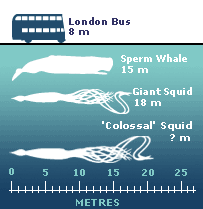The Deep Blue Sea


The Deep Blue Sea
by: Abhishek Varma
I was once watching this documentary on the discovery chanel, about the dangerous creatures that live at the bottom of the ocean. The environment is so harsh that these animals have to adapt and evolve in such radical ways that make them appear as something we have never before seen. I will be reflecting on some of the most interesting deep sea creatures isaw on the program and later did research on.
The Colossal Squid: The stuff dreams are made of. The monsters prowl the bottom of the ocean.. almost invisible. Although the world regards the chameleon as the most apt at camouflage, the title actually goes to the octopus and squid family. While the chameleon takes about 2 mins to fuly change its colour across the visible spectrum ( from red to blue), the octopus takes about 2 seconds. And not only does it change colour, it also changes its texture, whether rock like the corals, or smooth like the sand. In fact, the mimic octopus makes its tentacles look like sea snakes when seeking protection and mimics the coral weed when ambushing prey. The colossal squid just remains the same shade of deep, dark blue. The only deep sea animal that ca effectively detect the squid is the sperm whale, which I will elaborate on later on. The squid often gets into a tussle with the sperm whale, which happens to be the largest animal in the world with teeth. When attacked, the squid will suddenly turn into a flash of blood red, startling prey and even making the sperm whale pause for a fatal moment or so. The squids tentacles have sharp hooks which latch on to the whale and slowly rips through its skin and blubber and even its eyes.. In fact this battle is so evenly matched that the sperm whale wins only 6 out of ten times, albeit accidentally. The thing is the if the sperm whale remains mobile for long enough, it will need to surface for air, exploiting the squids only weakness, low pressure which will cause the squid to explode. Of course the squid will let go before the pressure gets to low, but it will be so weak that it just wont be able to tackle the sperm whale. If the fight lasts shorter than that, the squid will almost definitely win, with it tentacles, mobility, and speed. Unique adaptations
The tentacle club, the expanded distal portion of the tentacle, is endowed with two rows of swiveling hooks The beaks are the largest known of any squid , exceeding those of Giant squid in size and robustness
The eyes are probably the largest in the animal kingdom approximately the size of dinner plates.(even larger than those of the giant squid)
The relatively short arms are endowed with a combination of hooks and suckers.
The Sperm Whale: the only creature that can survive pressure at sea level, and at extremely high pressure. And probably the only creature that can survive a fight with the colossal squid.
The sperm whale is a toothed whale that lives in pods. It has a huge brain that weighs about 20 pounds (9 kg); it is the largest brain of any animal. The sperm whale has a single blowhole that is s-shaped and about 20 inches long. The blowhole is located on the left side of the front if its huge head. The sperm whale has a 4-12 inch thick layer of blubber.
Sperm whales produce ambergris, a dark, waxy substance (related to cholesterol) that is produced in the lower intestines, and is sometimes found containing squid beaks. Ambergris may help protect the sperm whale from the stings on the giant squid, its major food. However, it does not provide much protection agaist th ecollosal squid's beak. Large lumps of ambergris may be vomited up by the sperm whale. It is able to ‘see’ in the darkness by detecting electric pulses made by animals.
The fictional Moby Dick was a sperm whale.
The Angler fish: probably the most bizarre sea creature alive. It has massive teeth and it is able to survive deep sea pressure. It also has its characteristic light connected to the top of its head, that glows in the darkness. The spine protrudes above the fish's eyes, with a fleshy growth at the tip of the spine . This growth can be wiggled so as to resemble a prey animal, and thus to act as bait to lure other predators close enough for the anglerfish to devour them whole. To accomplish this, the anglerfish is able to distend both its jaw and its stomach (its bones are thin and flexible) to enormous size, allowing it to swallow prey up to twice as large as its entire body.
However, the most bizarre feature will probably be its mating adaptation. As it is very difficult to locate the male( which is 40 times smaller than the female) in the darkness of the sea, once it finds a male, the male goes and and bites it the female at the rear. Once it bites, it never lets go. Its head dissolves itno the female’s skin and its blood stream connects to the blood stream of the female. It gets its nutrients from the blood stream of the female. Whenever the female feels like it, it will send a chemical signal to the male and it will fertilize her. When a male anglerfish hatches, it is equipped with extremely well developed olfactory organs that detect scents in the water. They have no digestive system, and thus are unable to feed independently. They must find a female anglerfish, and quickly, or else they will die. This is an extreme example of sexual dimorphism.( A distinct difference in appearance between males and females of the same species)
